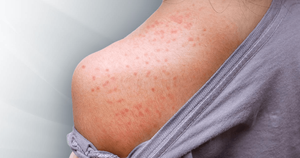Presentation and Stages of Infection
Clinical Presentation
The hallmark features of measles are high fever (above 38.3 °C), cough, coryza, conjunctivitis and a generalized erythematous maculopapular rash (Figure 2-1a) which begins on the face and spreads cephalocaudally (downward) and centrifugally (outward). The rash is so characteristic that many other viral exanthems are colloquially called “morbilliform”, which means “measles-like”. In the prodromal phase (see Stages of the Infection below), millimetric white or grey enanthema known as Koplik spots (Figure 2-1b) may develop in the buccal mucosa (and more rarely, on the conjunctiva, vaginal mucosa, or gastrointestinal mucosa). Koplik spots are considered pathognomonic for measles, and can be seen in 50-70% of patients with timely examination.
Common complications of measles include laryngotracheobronchitis or croup (up to 20% of patients), otitis media (7-9%), diarrhea (8%) and bronchopneumonia (1-6%). Acute encephalitis occurs in about 1 in…
To continue reading
Log in or register to continue reading. It's free!
OR
By signing up to create an account, I accept Healio's Terms of Use and Privacy Policy.
Clinical Presentation
The hallmark features of measles are high fever (above 38.3 °C), cough, coryza, conjunctivitis and a generalized erythematous maculopapular rash (Figure 2-1a) which begins on the face and spreads cephalocaudally (downward) and centrifugally (outward). The rash is so characteristic that many other viral exanthems are colloquially called “morbilliform”, which means “measles-like”. In the prodromal phase (see Stages of the Infection below), millimetric white or grey enanthema known as Koplik spots (Figure 2-1b) may develop in the buccal mucosa (and more rarely, on the conjunctiva, vaginal mucosa, or gastrointestinal mucosa). Koplik spots are considered pathognomonic for measles, and can be seen in 50-70% of patients with timely examination.
Common complications of measles include laryngotracheobronchitis or croup (up to 20% of patients), otitis media (7-9%), diarrhea (8%) and bronchopneumonia (1-6%). Acute encephalitis occurs in about 1 in 1,000 cases and may result in permanent brain damage or death. Inclusion body encephalitis may occur in immunocompromised patients months or years after the infection. Subacute sclerosing panencephalitis, an indolent and relentlessly progressive disease caused by persistent infection with a mutated strain of the wild-type virus, was once considered extremely rare; recent data suggest, however, that the incidence may be as high as 1 in 1,400 cases of measles.
Laboratory abnormalities commonly occur in measles. Among hospitalized patients with measles, leukopenia (primarily driven by lymphopenia) is the most common laboratory abnormality (36%); others include hyponatremia (14%), thrombocytopenia (9%), and pancytopenia (3%) and hypocalcemia (2%).
Measles during pregnancy is associated with increased risk of maternal, fetal and neonatal complications, including spontaneous abortion and stillbirth. In the United States (US), death from measles (usually due to a respiratory or neurological complication) is rare in the post-elimination era, with a case-fatality ratio (CFR) of 0.1-0.3%. Although the CFR has declined globally since the 1990s, in low- and middle-income countries it was comparably high (2.2%) in the period 1990-2015.
The risk of severe complications and death is influenced by the age of the patient (higher for younger patients), their nutritional and vaccination status (higher for malnourished and unvaccinated patients), and healthcare access. Immunosuppressed individuals (e.g., those with HIV or cancer) are also at increased risk of severe disease and death. The CFR can be as high as 20% or more among children caught up in major humanitarian crises. It should also be noted that measles infection itself may cause malnourishment via several mechanisms, including decreased food intake, the metabolic demands of the infection and loss of nutrients in the gastrointestinal tract. Vitamin A deficiency may occur in patients with measles, which, if severe, may manifest as xerophthalmia (dry eyes), keratitis, keratoconjunctivitis and Bitot’s spots (aggregations of keratin in the conjunctiva). Additional factors that likely influence the risk of severe infection and death include the intensity of exposure to the virus (e.g., transmission within a household) and genetic factors, particularly polymorphisms in the human leukocyte antigen (HLA) genes.

Stages of the Infection
The incubation period ranges from 7 to 14 days, although incubation periods of up to 23 days have been reported. The prodromal phase, which lasts for 2-4 days, is characterized by malaise, fever and one or more of the “three Cs” – cough, coryza and conjunctivitis. This phase of measles can be difficult to distinguish from other respiratory viral infections.
Koplik spots may appear 1-2 days after the onset of prodromal symptoms. The characteristic maculopapular rash appears at this stage (2-4 days after fever initiation), while Koplik spots, if present, may persist for another 1-2 days after the onset of rash. The rash typically starts on the face or behind the ears and then spreads downward and outward from the head, lasts for 3-6 days, and fades in the order in which it appeared. Conjunctivitis commonly appears contemporaneously with the rash, and may result in photophobia. Because both rash and conjunctivitis occur as a consequence of immune clearance of measles morbillivirus (MeV)-infected cells, they may not appear in patients with immune deficiency.
Patients with uncomplicated measles make a full recovery within 7 days of the onset of rash. However, the immune suppression associated with MeV infection (see Basic Virology), which may be long-lasting, increases the risk of secondary bacterial and viral infections, which are responsible for some of the complications described in the Presentation subsection. The course of a typical measles infection and its associated clinical signs and symptoms are shown in Figure 2-2.

References
- Bellini WJ, Helfand RF. The challenges and strategies for laboratory diagnosis of measles in an international setting. J Infect Dis. 2003;187 Suppl 1:S283-S290.
- Bharti N, Tatem AJ, Ferrari MJ, Grais RF, Djibo A, Grenfell BT. Explaining seasonal fluctuations of measles in Niger using nighttime lights imagery. Science. 2011;334(6061):1424-1427.



